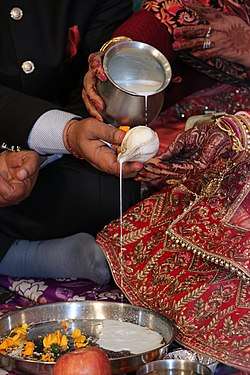Kanyadan
Kanyādāna ("gift of a maiden"[1]) is a Hindu wedding ritual.[2][1] and one possible origin of this tradition can be traced to 15th century stone inscriptions found in Vijayanagara empire in South India[3]. There are different interpretations regarding kanyādān across India (South Asia).

Origin
Practice of dowry among citizens appear in 15th century as can be evidenced in the several stone inscriptions found in Vijayanagara empire. Several incidents recorded in these inscriptions show that there was a wide spread practice of bride price (form of dowry where groom pays money or possessions to the bride), possibly influenced by Islamic Mahr into South India[4], during marriages. To fight the epidemic of bride price, a community group of Brahmins created a social legislation to adopt the marriage system of kanyadana for their community. It was mandated that no money should be paid or received during marriage and those who do not follow are liable for punishment by the King. The above inscriptions also reinforce that system of social legislations within community groups was widely in practice as against personal laws based on religious scriptures.[3]
Significance
The word 'kanyādana' is made of two parts, 'kanyā' meaning unmarried girl and 'dāna' meaning 'charity' or 'to give away'.
Of all dānas, annadāna (provide food) is considered supreme from the perspective of the receiver, as food is needed for survival.
From perspective of the giver (in this case the girl's father), kanyādāna is considered supreme because you give away what you love the most - your own daughter - to another family.
Kanyādāna songs
In communities where kanyādāna is performed as part of the actual wedding, the ritual is carried out through a variety of kanyādāna songs. These songs may include the parents lamenting the loss of their daughter, as well as regretting their economic sacrifice for the wedding. Other songs focus on the groom, for example comparing him to the "ideal groom", the god Rama, in the epic Ramayana. Importantly, the kanyādān ritual occurs right before the Sindoor ritual (sindurdan).[6]
See also
References
- “India.” Encyclopædia Britannica. 2008. Encyclopædia Britannica Online. 20 February 2008. <http://ripley.sbc.edu:2080/eb/article-46444%5B%5D>.
- Enslin, Elizabeth. “Imagined Sisters: The Ambiguities of Women’s Poetics and Collective Actions.” Selves in Time and Place: Identities, Experience, and History in Nepal. Ed. Debra Skinner, Alfred Pach III, and Dorothy Holland. Lanham; Boulder; New York; Oxford: Rowman & Littlefield Publishers, Inc., 1998 (269-299).
- Mahalingam, T.V (1940). Administration and Social Life under Vijayanagar. University of Madras. pp. 255-256.
- Dr.B. S. Chandrababu, and Dr.L. Thilagavathi. Woman, Her History and Her Struggle for Emancipation. p. 266.
- http://periva.proboards.com/thread/12692/kannikadhanam
- Henry, Edward O. “Folk Song Genres and Their Melodies in India: Music Use and Genre Process.” Asian Music (Spring-Summer 2000). JSTOR. 20 February 2008.
Further reading
- Gutschow, Niels; Michaels, Axel; Bau, Christian (2008). The Girl's Hindu Marriage to the Bel Fruit: Ihi and The Girl's Buddhist Marriage to the Bel Fruit: Ihi in Growing up - Hindu and Buddhist Initiation Ritual among Newar Children in Bhaktapur, Nepal. Otto Harrassowitz Verlag, Germany. ISBN 3-447-05752-1. pp. 93-173.
